By Alfredo Santana
Contributing Writer
VERNON — Two Sterigenics facilities that sterilize medical equipment have agreed to reduce ethylene oxide emissions under a plan approved by the South Coast Air Quality Management District, or face partial or complete shutdowns.
The Early Action Reduction Plan calls for the installation of four air pollution monitors to detect high levels of the carcinogen chemical, also known as EtO, that may pose hazards to onsite workers and others near the facilities, capping emissions at 17.5 parts per billion, or ppb.
If at any time emissions reach the 17.5 ppb level, but are lower than 25 ppb, the facilities will have to reduce operations by 20%. Whenever ethylene oxide releases are measured at 25 ppb or higher, Sterigenics would have to cut operations by 50%.
Located at 4801-63 E. 50th St., and 4900 S. Giffords Ave, the plants would have to curtail operations by 50% if a second reading conducted at least 24 hours after the initial results at or above 17.5 ppb, but does not climb to 25 ppb.
A second air ambience reading at or above 25 ppb would require the company to order complete shutdowns.
Similarly, a third reading yielding 17.5 ppb would trigger a full closure, until a following measure from the monitor that captured elevated emissions results below the threshold, with the condition that results from the other monitors are also below the limit.
The emissions reduction plan gives the AQMD leverage to take over air monitoring at the facilities if three samples are invalid from any of the four stations during a period of 30 days in a row.
The four monitors are installed near ground level at the curbside on 4900 S. Giffords Ave., next to a railroad track used to load and unload goods at the East 50th Street site, at a container storage yard on East 50th Street, and at a lot on East 49th Street near District Boulevard.
Also, Sterigenics will have to maintain records for daily ethylene oxide usage at both locations for a minimum of two years, and keep records related to any operation curtailment triggered by higher than permitted emissions while the company works on permanent solutions to capture airborne releases.
All records should be provided to the SCAQMD staff upon request, the document said.
A letter signed by Ian MacMillan, assistant deputy executive officer of planning, rule development and implementation for the SCAQMD, acknowledged that Sterigenics submitted the early action reduction plan on Sept. 2, in compliance with Rule 1402, to lower cancer risks linked with toxic chemical releases.
The letter was emailed to Kevin Wagner, vice president of environmental health and safety for Sterigenics US, and notifies him that the company should also comply with the submittal of an air toxics inventory report on or before Nov. 4, and a health risk assessment and a risk reduction plan by Dec. 6.
“Please note that the [risk reduction plan] will need to include risk reduction measures to reduce the impact of total facility emissions below the action risk level as quickly as feasible,” MacMillan said in the letter. “Additional risk reduction measures beyond those specified in the early action reduction plan may be needed to account for updated information on facility emissions and health risks as they become available.”
In the early action reduction plan, Sterigenics pointed at two defective scrubbers and two abators as responsible for the high concentration levels, in addition to “various fugitive sources” the company should monitor and control in both the short and long term to reduce hazardous releases.
Ethylene oxide is purchased by Sterigenics to inject it at enclosed chambers to disinfect catheters, IVs, surgical equipment and even COVID-19 test kits.
Sterigenics, one of three units that belong to Sotera Health Company, has added internal ethylene oxide containment measures such as thick plastic sheets and strip curtains to block escapes from enclosed areas to corridors and aeration rooms, and installed dry beds systems to capture releases.
Pending agency approval, Sterigenics plans to install and operate two permanent total enclosures, to be operational by Jan. 15, 2024 for the 50th Street facility, and on May 1, 2024 for the 49th Street plant, unless construction and permit extensions are sought.
The plan’s current release thresholds are more stringent than those proposed at a board hearing in August, but are still significantly higher than those at 3.18 ppb the Office of Environmental Health Hazard Assessment considers a risk for 100 people in a million to develop cancer.
For illustration, the SCAQMD estimated that the chances to get cancer for people near the operations at ground level rises at 575 per million if the exposure persists for 25 years with an 18.3 ppb daily release average.
According to an air quality monitoring data table the agency updates every three days, the two sterilizing facilities have not released amounts higher than 17.5 ppb in more than two months, but recorded 18 of 21 emissions above legal levels.
A Sterigenics spokesperson said that the Vernon operations sterilize more than 45 million devices a year, many of those supplied to nearly 100 health care product manufacturers and dozens in Los Angeles, and provides more than 40 well-paying jobs in the area.
“The early action reduction plan reflects Sterigenics’ commitment to further enhancing the already safe operations at its Vernon facilities for the continued safety of local employees and community members,” the spokesperson said in a written statement. “Sterigenics has already made progress on these emission reduction initiatives and looks forward to executing on remaining … commitments as it continues to fulfill its critical role in health care through the sterilization of over 45 million essential medical devices and supplies at the Vernon facilities each year.”
County Supervisor Janice Hahn, a fierce critic of the air quality agency’s process that allows Sterigenics to stay open even though it does not comply with state regulations, called the plan a step in the right direction.
“I continue to believe that this facility needs to be shut down until they can lower their emissions to legally allowed levels, but this new SCAQMD order is a substantial improvement over what had last been proposed and one step closer toward lowering these toxic emissions and making the air in and around Vernon safe for workers and residents alike,” Hahn said in a statement.












